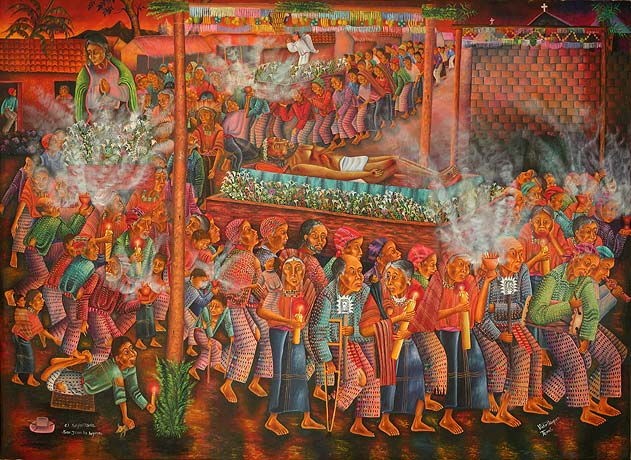
El Sepultado
(The Entombment)
1998
56" x78", oil on canvas
Victor Vasquez Temó
Every year at Easter a procession commemorating the entombment and resurrection of Christ leaves the church in San Juan la Laguna. It slowly advances around the central part of town before returning to the church. Everyone wears the traje [traditonal dress] of San Juan la Laguna. The young men of the town support the exceedingly heavy, larger-than-life-sized wooden coffin with the image of the dead Christ. Hopeful of benediction each of the young men carrying the coffin has paid for this honor. Since more men and boys want to carry the coffin than there are spaces, young men relieve or replace those who started. The procession moves slowly—two steps forward and one step back. This gives the coffin a rocking motion which is easier to endure for a long period. The route of the procession would only take about five minutes to walk, but takes about an hour at the slow pace. The town has been decorated at various points along the route with palm fronds, fruits and colored paper hanging from a beam supported between two poles. The procession includes Texeles, the women carrying very large candles, along with incense carriers and musicians. In the painting two men carry staffs topped with the silver emblems of the cofradia [religious brotherhood] they represent.
Among the people participating in or watching the procession Victor has included three disabled people—a man with one crutches and a silver cofradia staff, a young boy with sticks for crutches, and a crazy man on a mat. Perhap dealing with the dysfunction of his legs has affected his mental state. Anyone visiting a third world country will notice the high proportion of disabled people there. Because no safety standards exist in countries like Guatemala, far too many work accidents kill or maim people. The nearest hospital across the lake in Solola is under the best conditions an hour away. Medical care when available is minimal and beyond what most campesinos can afford. Behind the crazy man on the mat a young girl carries her baby brother on her back. Young Mayan children often bear the responsibility of taking care of still younger siblings freeing the mother for other responsibilities—making tortillas, cooking beans, weaving, and buying or selling in the market.